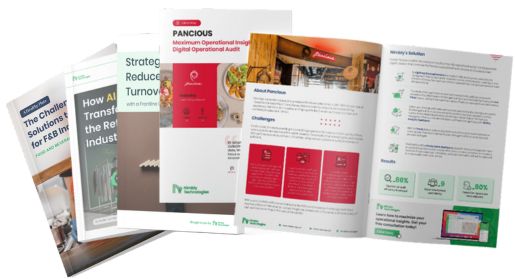

Picture this: you're at the helm of a thriving restaurant chain with multiple locations, each bustling with activity and serving up delicious dishes to loyal patrons day in and day out. While the aroma of your signature dishes fills the air and the hum of satisfied diners fills your ears, behind the scenes, it's your operational plan for restaurant that keeps the entire operation running like a well-oiled machine.
Whether you're overseeing an established restaurant chain with numerous stores or looking to fine-tune operations for continued success, having a robust operational plan is the key to maintaining consistency, efficiency, and profitability across all locations.
So, how do you ensure that your restaurant chain is firing on all cylinders? Let's dive into a comprehensive guide that will help you optimize operational excellence across your entire restaurant chain, ensuring each store reaches its full potential.
Just as each dish on your menu has its own unique flavor profile, each location in your restaurant chain should have its own distinct identity and purpose. Start by defining the overarching goals and objectives for your chain, taking into account factors such as target demographics, market positioning, and growth aspirations. These goals will serve as the guiding stars that align your entire operation and drive success across all stores.
Example: Suppose your restaurant chain aims to expand its market reach by targeting urban millennials while maintaining its reputation for high-quality, locally-sourced ingredients. In this case, your goals may include increasing foot traffic at each location by 15% within the next year, launching a social media campaign to engage with younger demographics, and introducing a new line of plant-based menu items to cater to health-conscious consumers.
With multiple locations under your belt, it's crucial to take stock of the resources and constraints that shape your chain's operations. From staffing and equipment to supply chain logistics and store layouts, understanding the ingredients and constraints at play will help you tailor your operational plan to each location's unique needs and challenges.
Example: Let's say one of your restaurant locations is facing challenges with kitchen space and equipment limitations, leading to bottlenecks during peak hours. By conducting a thorough assessment, you identify the need to invest in kitchen renovations and equipment upgrades to improve workflow efficiency and increase throughput. Additionally, you may explore opportunities to streamline inventory management processes to optimize space utilization and reduce waste.
Also read: 7 Effective Restaurant Inventory Tips
Just like sampling your restaurant's offerings, conducting a SWOT analysis allows you to identify the strengths, weaknesses, opportunities, and threats facing your business. Take a close look at each store's performance, considering factors such as customer satisfaction, competition, and market dynamics. This analysis will provide valuable insights that inform your operational strategies and help you capitalize on opportunities for growth and improvement.
Example: Consider conducting a SWOT analysis for one of your restaurant locations. You identify that one of its strengths is its prime downtown location, attracting a steady flow of foot traffic. However, a weakness is its limited parking availability, which may deter some customers from dining in. An opportunity may be to launch a valet parking service to enhance the customer experience and alleviate parking concerns, while a threat could be increased competition from new restaurant openings in the area.
Now it's time to develop operational strategies and specials that set your restaurant chain apart from the competition. Whether it's introducing innovative menu items, optimizing staffing levels, or launching targeted marketing campaigns, develop strategies that align with your chain's goals and leverage its strengths. By tailoring your strategies to each location's unique attributes, you'll ensure that every store contributes to the overall success of your chain.
Example: Suppose one of your restaurant locations is experiencing a slowdown in weekday lunch sales. To address this, you decide to launch a lunchtime loyalty program offering discounts and rewards for repeat customers. Additionally, you introduce a new express lunch menu featuring quick and affordable options tailored to busy professionals. By leveraging your location's proximity to office buildings and offering value-added incentives, you aim to boost lunchtime traffic and drive incremental sales.
Also read: 4 Benefits of Loyalty and Reward Programs for Restaurants
With your strategies in place, create a detailed action plan for implementing them across your restaurant chain. Clearly outline the steps to be taken, along with timelines, responsibilities, and performance metrics. By breaking down your plan into actionable tasks, you'll ensure that each store knows exactly what needs to be done to achieve your chain's objectives and drive results.
Example: Develop a comprehensive action plan for rolling out the lunchtime loyalty program and express lunch menu across all locations. Assign specific tasks to each store manager, such as updating menus, training staff on the new offerings, and implementing promotional activities. Set clear deadlines for each task and establish key performance indicators (KPIs) to track the success of the initiative, such as increases in weekday lunch sales and customer retention rates.
Also read: The Solution to Frontliner Training
Once your operational plan is in motion, it's essential to monitor performance closely, gather feedback from customers and staff, and be prepared to make adjustments as needed. Keep a finger on the pulse of each store's operations, and be agile and responsive to changes in the market landscape. By continuously fine-tuning your operational plan, you'll ensure that your restaurant chain remains dynamic, resilient, and successful in the face of evolving challenges.
Example: Monitor the effectiveness of the lunchtime loyalty program and express lunch menu rollout by tracking sales data and soliciting feedback from customers and staff. If certain locations are not meeting performance targets, analyze the root causes and implement corrective actions, such as adjusting menu offerings, refining promotional strategies, or providing additional training and support to store teams. By staying proactive and responsive, you'll maximize the success of your operational initiatives and drive sustained growth across your restaurant chain.
Investing in staff training and development is crucial for ensuring consistent service quality across all your restaurant chain's locations. Develop comprehensive training programs covering various aspects such as food preparation techniques, customer service protocols, and health and safety procedures. Assign experienced trainers or department heads to oversee training sessions and provide ongoing support to new hires.
Example: Implement a structured onboarding program for new employees at each restaurant location. This program can include shadowing experienced staff, interactive training modules, and hands-on practice sessions. Regular refresher courses and skills workshops can also be organized to keep existing staff updated on the latest industry trends and best practices.
Efficient supply chain management is vital for ensuring that each restaurant in your chain has access to fresh, high-quality ingredients. Establish strong relationships with trusted suppliers and negotiate favorable terms to ensure reliable and timely deliveries. Implement inventory management systems to track ingredient usage, monitor stock levels, and streamline ordering processes.
Example: Partner with local farmers or food producers to source fresh, seasonal ingredients for your restaurant chain. By sourcing locally, you can reduce transportation costs, support the local economy, and offer unique menu items that resonate with environmentally-conscious customers. Regularly assess supplier performance and conduct quality checks to ensure that your ingredients meet your chain's standards.
Maintaining consistent quality across all aspects of your restaurant chain's operations is essential for building a strong brand reputation and fostering customer loyalty. Implement robust quality assurance protocols covering food preparation, presentation, cleanliness, and customer service standards. Conduct regular inspections and audits to identify areas for improvement and address any deviations from established standards promptly.
Example: Develop standardized operating procedures (SOPs) for each area of restaurant operations, including food preparation, sanitation, and customer interactions. Train staff on these SOPs and conduct regular performance evaluations to ensure compliance. Implement customer feedback mechanisms, such as comment cards or online surveys, to gather insights into customer satisfaction levels and identify areas for improvement.
Also read: 10 Key Benefits of Quality Assurance (QA) for Your Business
Effective financial planning and budgeting are essential for maintaining the financial health of your restaurant chain. Develop detailed budgets that allocate resources effectively across all locations, taking into account expenses such as food and beverage costs, labor costs, overhead expenses, and marketing expenditures. Monitor financial performance regularly and adjust spending priorities as needed to optimize profitability.
Example: Use budgeting software or financial management tools like Aspire to track expenses and revenue across all restaurant locations in real-time. Set specific financial targets for each location, such as achieving a certain profit margin or controlling food costs within a specified range. Conduct regular financial reviews to identify variances from budgeted targets and take corrective actions to address any discrepancies.
Effective marketing and promotions are essential for driving customer traffic and generating revenue for your restaurant chain. Develop comprehensive marketing strategies that leverage both traditional and digital channels to reach your target audience. Create compelling promotional campaigns that highlight your chain's unique offerings and encourage customer engagement and loyalty.
Example: Launch a social media marketing campaign to promote a new menu item or seasonal promotion at your restaurant chain. Use engaging content, such as mouth-watering food photos or behind-the-scenes videos, to capture the attention of your target audience and drive traffic to your restaurant locations. Offer exclusive discounts or incentives for customers who follow your restaurant chain on social media or sign up for your email newsletter.
Also read: Make sure your Promotion initiatives are executed properly.
Embracing innovation and continuous improvement is essential for staying ahead of the competition and adapting to evolving consumer preferences. Encourage a culture of creativity and experimentation within your restaurant chain, and be open to trying new ideas and approaches to enhance your operations and customer experience.
Example: Implement new technologies or digital solutions to streamline operations and enhance efficiency at your restaurant chain. For example, you could invest in a mobile ordering app or online reservation system to improve the customer ordering process and reduce wait times. Conduct regular brainstorming sessions or innovation workshops with staff to generate ideas for improving service quality, optimizing workflows, or introducing innovative menu offerings.
Also read: Driving Operational Excellence in KFC and Taco Bell Indonesia
By following these steps and incorporating detailed examples, you can effectively optimize operational excellence across your restaurant chain and ensure its long-term success and profitability. Each example illustrates practical strategies that can be implemented to enhance various aspects of your restaurant chain's operations, from staff training and supply chain management to financial planning and marketing initiatives.
It's crucial to steer clear of common pitfalls that can derail our efforts. Here's a rundown of what to avoid when crafting and executing operational plans within the food and beverage industry:

Smooth communication is the cornerstone of successful operations. When communication falters, it can lead to misunderstandings among staff, resulting in missed assignments or unreported issues. Moreover, miscommunication between departments can spawn chaotic situations that are challenging to rectify swiftly.
Operational planning devoid of a clear strategic focus risks squandering resources and time. Without a solid strategic framework, teams may struggle to efficiently pursue goals, especially when confronted with unexpected challenges.


Strategic decisions should harmonize with overarching goals, financial objectives, and standard operating procedures (SOPs). Misalignment in decision-making can trigger clashes, wastage of resources, and dampened employee motivation.
Failure to anticipate long-term challenges can spell disaster for F&B businesses. Unexpected spikes in operational costs, a cascade of unresolved issues, or declining product quality can quickly erode profitability. To safeguard against such risks, it's imperative to adopt preventive measures and ensure that operations consistently adhere to SOPs.

Here's how to harness digital management tools like Nimbly to streamline and enhance your operational planning process:
Digital management tools, such as Nimbly, offer invaluable assistance to managers and team leaders striving to craft exceptional operational plans. Equipped with features like digital checklists and issue trackers, Nimbly ensures that every strategic step in your plan is meticulously executed.
One of Nimbly's standout benefits lies in its transparency-enhancing capabilities. Through its centralized dashboard, stakeholders gain real-time visibility into operational progress. This transparency fosters seamless collaboration among employees, managers, and team leaders responsible for operational oversight.
By leveraging Nimbly's features, businesses can facilitate more thorough reviews and evaluations of their operational programs. Sharing digital checklists and performance metrics allows stakeholders to assess progress comprehensively and identify areas for improvement. This heightened visibility empowers teams to make data-driven decisions and fine-tune operational strategies effectively.
In the dynamic landscape of the food and beverage industry, operational planning is paramount for achieving desired results and maintaining control. Nimbly serves as a catalyst for transparent operation planning, enabling businesses to navigate complexities with confidence.
Ready to experience the transformative power of transparent operational planning and control? Take advantage of our FREE consultation session to explore how Nimbly can elevate your business's operational efficiency and effectiveness. With Nimbly by your side, unlocking operational excellence has never been easier.
